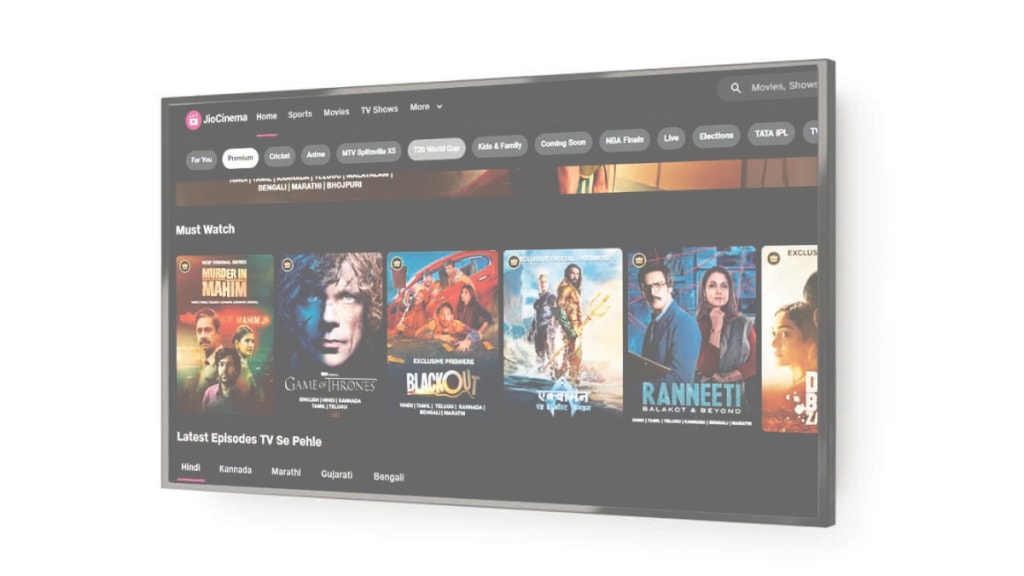Earlier this year, JioCinema made an audacious gamble, slashing its subscription rate to just 29 per month — that’s less than1 per day — for access to its premium, ad-free content. Competitor Netflix starts its mobile-only plans at 149 per month, with Basic plans beginning at 199. Amazon Prime Video’s ad-free annual subscription costs 1,499, translating to approximately 125 per month, or 299 per month if billed on a monthly basis. Zee5, another big competitor, charges 199 for its monthly plan.
Now look at JioCinema’s content platter. Post merger with Disney + Hotstar, it will have access to Star, Disney Animation films, Marvel, Pixar, Lucasfilm, Searchlight, and 20th Century Studios hits. Popular programming from HBO and Paramount+, featuring titles like Harry Potter and Game of Thrones, along with content from Colors TV are on the roster already.
JioCinema has extensive sports content too—including marquee events such as the Indian Premier League (IPL), the Olympics, and the FIFA World Cup. After the merger, it will control almost 75% of the sports streaming market across linear TV and digital platforms, estimates Elara Capital. This will also give Jio close to 80% share of the overall sports advertisement market, setting up “the media juggernaut for immense growth in an industry where sports is a key driver of viewership on both TV and digital platforms”, says Karan Taurani, an analyst at Elara Capital.
So is JioCinema set to pull off another coup, this time in OTT?
In its first eight years, JioCinema was haunted with problems — chief among them was a lack of stability. The service crashed often during its first IPL streaming season, and when it didn’t, there were lag times. The programming selection was limited.
Much has changed since then.
Since acquiring the digital rights to IPL, it has beefed up its backbone, ensuring the infrastructure is capable of handling the massive load of 20 million concurrent devices. “The Disney partnership gives them the content and credibility they need to compete with global players,” says Ambika Sharma, founder and chief strategist, Pulp Strategy.
A new beginning
JioCinema appears to position itself as the go-to destination for everyday viewing, focusing on everyday “dal-chawal” content — to borrow a phrase from Pinaki Dasgupta, professor of marketing at IMI New Delhi. This explains the absence of high-cost Bollywood productions or extravagant platform-exclusive shows like Made in Heaven (Prime) or Heeramandi (Netflix), that require between 40 crore and 50 crore to produce and market. As one insider notes, “It is very difficult to get returns on such investments purely on the back of subscriptions.”
Given that, JioCinema is looking to generate multiple revenue streams. Take Bigg Boss Hindi. The show premieres on television and is complemented with additional content, with a 24×7 live stream for premium subscribers. The AVOD audience can wait to see the episode as aired on TV, on the platform.
There is also a concerted effort to ramp up in-show placements, besides sponsorships and advertising. “Monetisation through ads, subscriptions, and collaborations will be key to long-term profitability,” says Yasin Hamidani, director, Media Care Brand Solutions.
With subscription revenues at rock bottom, can advertising and partnerships sustain growth? “The OTT market had evolved to a point where people got accustomed to paying. Jio is turning the market into a state of freebies,” notes Taurani.
The amount that JioCinema coughed up to acquire the sports rights are likely to result in substantial losses, Taurani adds. “These losses won’t be offset by the subscription revenues,” he says. “Even with a 10-15% annual growth rate, the losses could approach $700-800 million a year for the next three years. The current subscription rates are insufficient to achieve break-even.”
But Jio is the master of the price game. When it entered the telecom market in September 2016, it disrupted the whole industry by offering free voice and data services in the first six months. This led to a paradigm shift in the market, upending players’ pricing strategies and users’ data consumption habits and forcing big competitors into consolidation. Jio logged 50 million subscribers in about 80 days of launch, a milestone that competitors Airtel and Vodafone took over a decade to achieve.
This time, Jio simply needs to find a way to turn nonconsumers into consumers.


